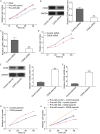MiR-29b suppresses the proliferation and migration of osteosarcoma cells by targeting CDK6
- PMID: 27230400
- PMCID: PMC4887333
- DOI: 10.1007/s13238-016-0277-2
MiR-29b suppresses the proliferation and migration of osteosarcoma cells by targeting CDK6
Abstract
Osteosarcoma is the most common primary sarcoma of bone, and it is a leading cause of cancer death among adolescents and young adults. However, the molecular mechanism underlying osteosarcoma carcinogenesis remains poorly understood. Recently, cyclin-dependent kinase 6 (CDK6) was identified as an important oncogene. We found that CDK6 protein level, rather than CDK6 mRNA level, is much higher in osteosarcoma tissues than in normal adjacent tissues, which indicates a post-transcriptional mechanism involved in CDK6 regulation in osteosarcoma. MiRNAs are small non-coding RNAs that repress gene expression at the post-transcriptional level and have widely been shown to play important roles in many human cancers. In this study, we investigated the role of miR-29b as a novel regulator of CDK6 using bioinformatics methods. We demonstrated that CDK6 can be downregulated by miR-29b via binding to the 3'-UTR region in osteosarcoma cells. Furthermore, we identified an inverse correlation between miR-29b and CDK6 protein levels in osteosarcoma tissues. Finally, we examined the function of miR-29b-driven repression of CDK6 expression in osteosarcoma cells. The results revealed that miR-29b acts as a tumor suppressor of osteosarcoma by targeting CDK6 in the proliferation and migration processes. Taken together, our results highlight an important role for miR-29b in the regulation of CDK6 in osteosarcoma and may open new avenues for future osteosarcoma therapies.
Keywords: miR-29b; migration; osteosarcoma; proliferation; tumorigenesis.
Figures





References
-
- Admassi D. Osteosarcoma of medial cuniform bone. Ethiop Med J. 2009;47:305–308. - PubMed
Publication types
MeSH terms
Substances
LinkOut - more resources
Full Text Sources
Other Literature Sources

